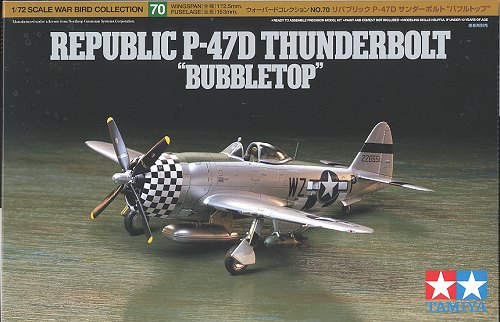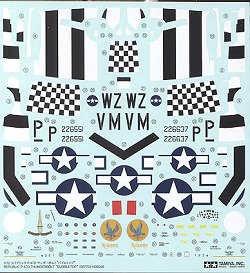
|
KIT: |
Tamiya 1/72 P-47D Thunderbolt (Bubbletop) |
|
KIT # |
60770 |
|
PRICE: |
¥1400 (about $13.00) from Hobby Link Japan |
|
DECALS: |
Two options |
|
REVIEWER: |
Scott Van Aken |
|
NOTES: |

|
HISTORY |
The USAAF thought they had a winner in this big plane and decided to use it as an escort fighter. Well, that didn't work out. Two reasons. One was that it had really poor climbing ability and the other was that it had poor range. Drop tanks were not considered to be the thing to use on an American plane, and even when production got underway, most of the tanks were not built in the US but in small garage companies in the UK! Even with drop tanks, their range was not what was expected, however, they packed a wallop with four .50 calibre machine guns in each wing.
When the brass of the USAAF finally pulled their heads out of their butts so they could listen to their pilots, they started using the Mustang as an escort fighter in late 1943, the P-47s were then free to do what they did best and that is act in the fighter-bomber role. That huge radial engine was a great chunk of armor plating protecting the pilot and when the plane was shot to pieces it still managed to bring the pilot home. There are numerous stories about the survivability of this aircraft. Even post war the plane was in service with the ANG and foreign countries. During Korea the then-USAF lamented about how quickly they scrapped the P-47 as the Mustang was not a great ground attack plane, mainly because of its liquid-cooled engine.
|
THE KIT |
 Tamiya started a program of down-sizing its 1/48 kits a few years back
and it has resulted in some of the finest 1/72 kits every produced. While
they simplified the aircraft somewhat by not offering things like
separate flaps and combining some parts, this made little
difference to most modelers and they were quickly gobbled up by
appreciative consumers. This has also happened with their P-47 line and
the bubble-top P-47D is the most recent. Now you'll have to excuse any
possibly lame comments from me as I've not bought any of the previous
1/72 or 1/48 Tamiya P-47s so have no baseline to go from other than this
kit.
Tamiya started a program of down-sizing its 1/48 kits a few years back
and it has resulted in some of the finest 1/72 kits every produced. While
they simplified the aircraft somewhat by not offering things like
separate flaps and combining some parts, this made little
difference to most modelers and they were quickly gobbled up by
appreciative consumers. This has also happened with their P-47 line and
the bubble-top P-47D is the most recent. Now you'll have to excuse any
possibly lame comments from me as I've not bought any of the previous
1/72 or 1/48 Tamiya P-47s so have no baseline to go from other than this
kit.
I was first pleased to see that they don't cram all their sprues into one bag. This may cost a tad more, but it keeps the plastic from being damaged in shipment. You get a very complete cockpit that makes into a little tub when you add the side walls. It has rudder pedals, a proper seat and you get decals for instruments and seat belts. Personally, I don't mind this at all and actually like the choice of decal belts over none. In my experience, the decal instruments will sit precisely over the raised detail on the panel.
There is a wing spar to fit in between the fuselage halves before you join them. The upper aft fuselage and fin is separate and split in half. I've not seen this done before in a kit, but apparently it works well. This kit is for a D version without the fin fillet. A poly cap fits in the engine block so you can simply push in the prop. Speaking of which, you get both a Hamilton Standard and a symmetrical Curtiss-Electric prop. Once again, Tamiya has done something new to me and the prop assemblies are in two parts which you glue together. An interesting way of doing it and it seems to take up less sprue space. I found it unusual that the gun barrel ports in the leading edge of the wing were separate and only included two barrels. The other two are added later in the build.
The kit offers a choice of either closed or spoked wheels. There
are also a number of inserts that go into the lower wing section,
undoubtedly to handle other variant differences. The under wing pylons
are also separate parts. This may be so that you can put them on over
insignia with minimal fuss or leave them off entirely if t here
is a requirement to do so. The canopy and windscreen are separate parts
so that you can show off the interior. For things under the plane you
have a choice. Drop tanks supplied are the large flattish 150 gallon
centerline and pair of 108 gallon paper versions for either the
centerline or wing pylons. A pair of 500lb bombs is provided as are the
infrequently used 4.5in rocket tubes. Other than the centerline stuff,
you'll have to open holes in the lower wings for the pylons or rockets.
here
is a requirement to do so. The canopy and windscreen are separate parts
so that you can show off the interior. For things under the plane you
have a choice. Drop tanks supplied are the large flattish 150 gallon
centerline and pair of 108 gallon paper versions for either the
centerline or wing pylons. A pair of 500lb bombs is provided as are the
infrequently used 4.5in rocket tubes. Other than the centerline stuff,
you'll have to open holes in the lower wings for the pylons or rockets.
Instructions are excellent but only reference Tamiya paints. Markings are for two planes, both in natural metal finish. One is the box art aircraft from 84 FS/78 FG in 1944. This one has a large checkered cowling and under surface Invasion stripes. The decals are in the proper number of pieces to fit these in place. The other is from the 551 FTS/495 FTG, which I have to assume is a training squadron. This aircraft has what appears to be a medium green anti-glare panel and nose. The color is a mixture of two Tamiya greens. It also does not carry any wing pylons. It carries the remnant of Invasion Stripes under the fuselage. The decals are well printed and appear to be properly opaque. Regardless, since they will be placed on bare metal, there should not be any bleed-through problems.
|
CONCLUSIONS |
P-47 enthusiasts who have been clamoring for a new bubbletop in 1/72 can now sell off their Academy, Revell, or Hasegawa kits if they wish and restock on nice, new Tamiya versions. I'm sure that the kit will practically fall together.
You can find this kit and many others at
 . "You have a friend in
Japan."
. "You have a friend in
Japan."
If you would like your product reviewed fairly and quickly by a site that has over 250,000 visitors a month, please contact me or see other details in the Note to Contributors.